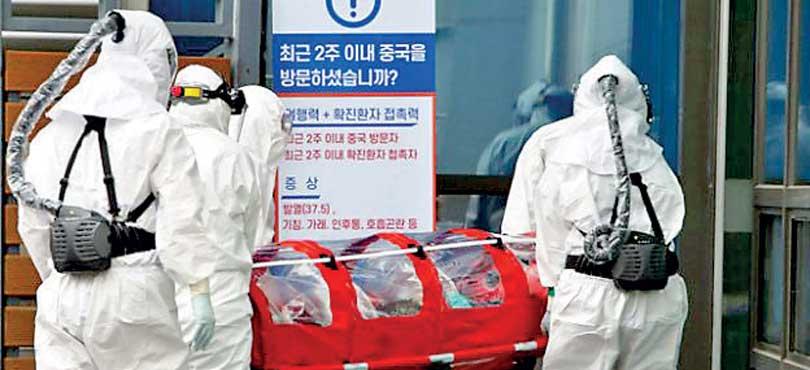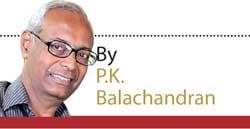Lockdown A principal way to contain COVID-19, fraying at the edges
 Medical workers wearing protective gear carry a patient infected with COVID-19 at a hospital in South Korea. (AFP)
Medical workers wearing protective gear carry a patient infected with COVID-19 at a hospital in South Korea. (AFP)- Agitations against the lockdown have taken place in about 25 States in the United States. In the UK, some conservative politicians have come out against it. In India, there have been violent resistance to being tested for COVID-19
- Trump is keen to move the national discussion from public health to the economy as he is widely flayed by the liberal media for not doing enough to fight the virus
- South Korea, which was among the first to be infected, contained the viral infection not with a lockdown but by testing widely and providing first rate medical treatment to the infected.

28 April 2020
The “lockdown”, as the principal way to contain the coronavirus pandemic, appears to be fraying at the edges now. Even as governments are extending the lockdown, driven by the advice of doctors and public health professionals, they cannot but take into account the growing opposition to it, at least in its present form.
The top leadership in some countries like Sri Lanka know the need of the people to get on with their lives for their own survival and for the survival of their country. The Sri Lankan government is therefore cautiously and selectively relaxing the lockdown regimen. This appears to be working.

There are those who openly say that the lockdown will do more harm than good, given its grave economic implications right across any country’s sectoral and social spectrum. Agitations against the lockdown have taken place in about 25 States in the United States. In the UK, some conservative politicians have come out against it. In India, there have been violent resistance to being tested for COVID-19 as nobody wants to be quarantined and deprived of a livelihood. The practice of sealing off whole areas is causing inconvenience to people, the majority of whom are perfectly healthy.
The top leadership in some countries like Sri Lanka know the need of the people to get on with their lives for their own survival and for the survival of their country. The Sri Lankan government is therefore cautiously and selectively relaxing the lockdown regimen
An upshot of this is the voicing of conspiracy theories about big pharma companies and hegemonic leaders and powers using the technique of scaremongering to subjugate the weaker sections of society and weaker countries. Those worried about democracy point to the possibility of concentration of power in the diabolical National Security State.
As Prime Minister Narendra Modi sitting in the Indian political capital New Delhi urged 1.3 billion Indians to make economic sacrifices to save lives and be in lockdown till May 3, police baton-charged protesting migrant workers in the industrial and commercial city of Mumbai. “From an economic point of view only, it undoubtedly looks costly. But measured against the lives of Indian citizens, there is no comparison,” Modi said.
In Mumbai, thousands of jobless migrant workers had congregated at a railway station, demanding to be allowed to travel to their homes in the villages. But the workers were baton-charged. These men and women were among hundreds of thousands who fled the big cities as all economic activity had ceased there thanks to the lockdown.
The US$ 3 trillion Indian economy, already in the doldrums, is limping as a result of the lockdown. Reuters quotes the Centre for Monitoring Indian Economy to say that unemployment has doubled to 14.5%.
Of course, governments have their own worries about the pandemic due to lack of testing equipment. Under the circumstances, lockdowns are a cheap and easy way of containing the infection. Testing is on but below par. Reuters reports that India has tested 137 per million compared with 15,935 per million in Italy, and 8,138 in the United States per million. For testing to be effective, it has to cover non-symptomatic people also, and that is a tall order. Scientists in the US and elsewhere also point out that there is a vested interest in declaring deaths as COVID-19 induced when these could have been due a weakened immune system or attendant conditions found usually in elderly people.
However, unlike in the US, in India, the decision to lockdown is not contested politically. What is contested is the government’s approach to the aftermath of the decision as reflected in the plight of the migrant workers and other poor people. The Congress says that the government has the food stocks and the money to meet the needs of the poor but it has failed to deliver them.
United States
In the US, opposition to the lockdown and social distancing rules is coming from the conservatives, Republicans and supporters of President Donald Trump. Pro-Trump banners are omnipresent at the protests, as he is eager to open the economy. And Trump, in turn, has praised the protesters as “very responsible people”.
Reports in The Guardian say that frustration is due to the fact that almost 95% of Americans are under “lockdown” with 42 states having issued stay-at-home orders. The number of unemployed is 21 million. The economic, social and educational disruption caused by shutdowns is guaranteed to cause significant, even greater harm, a petition to a State Governor said.
In Maryland, Texas and Ohio demonstrators demanded that Anthony Fauci, the top public health expert on the White House coronavirus task force, be fired. In Columbus, Ohio, hundreds of protesters gathered, some chanting “We are not sheep”.
Trump is keen to move the national discussion from public health to the economy as he is widely flayed by the liberal media for not doing enough to fight the virus through measures urged by medical and public health professionals. An article in “Nature” points out that university labs which are ready and able to run diagnostics are not operating at full capacity. An investigation of several university labs certified to test for the virus found that “they have been held up by regulatory, logistic and administrative obstacles, and stymied by the fragmented US health-care system.”
In January, WHO had vetted and distributed a German-developed PCR-based test for the virus. But rather than use this test, the US Centers for Disease Control and Prevention (CDC) developed its own. But for most of February, this was the only test permitted in the US, Nature says.
“The Guardian” reported from the US that in Texas, where the anti-shutdown protest was organised by conspiracy theorists, the language used was extreme, with talk of a “coronavirus hoax,” and the coronavirus being a “narrative of the Deep State”. The Heartland Institute posted a piece by Economics Professor Daniel Sutter arguing that alternative strategies to social distancing – like sheltering vulnerable populations “could have mitigated the human toll at a significantly lower economic and social cost”. A video put up by the Media Research Center said there is mass panic being generated by “lies and deception and exploiting ignorance.”
UK, France and Germany
Anti-lockdown sentiments are being voiced in the UK, Germany and France, turning violent in Paris. In the UK, Geoffrey Clifton-Brown, the treasurer of the 1922 Committee (which is the parliamentary group of the Conservative Party in the House of Commons) said: “We have to accept a bit of risk.”
Reports in The Guardian say that frustration is due to the fact that almost 95% of Americans are under “lockdown” with 42 states having issued stay-at-home orders
Swedish and South Korean Models
In a rally in Minnesota US, the protestors’ slogan was “Be like Sweden” because Sweden had shunned the lockdown and instead asked people to voluntarily observe social distancing and the elderly to be at home. Schools, restaurants and even bars are open.
South Korea, which was among the first to be infected, contained the viral infection not with a lockdown but by testing widely and providing first rate medical treatment to the infected. South Korea’s containment without stopping economic activity and disrupting normal life was so successful that the country held its parliamentary elections on April 15.
“But you need to plan and to stay one step ahead,” says South Korean Foreign Minister KangKyung-wha. “The Prime Minister created a task force of all government ministries and, crucially, all regional and city governments, too, because we are a very devolved democracy,” Kang said. In other words, it was not a “top down approach.” Every unit of the federal structure was involved in planning and strategising.
“ When one region ran out of hospital beds we asked other provinces to open up beds in their hospitals. When it ran out of doctors we asked doctors in other regions to help,” the Foreign Minister explained.
